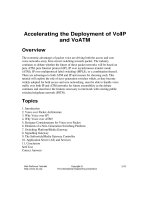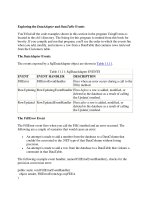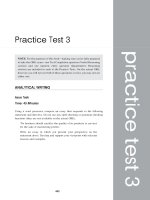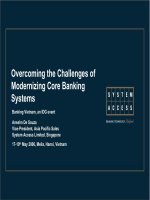Tài liệu Exploring the challenges of HIV- AIDS docx
Bạn đang xem bản rút gọn của tài liệu. Xem và tải ngay bản đầy đủ của tài liệu tại đây (988.21 KB, 79 trang )
Free download from www.hsrcpress.ac.za
Published by HSRC Press
Private Bag X9182, Cape Town, 8000, South Africa
www.hsrcpress.ac.za
First published 2007
ISBN 978-0-7969-2194-9
© 2007 Human Sciences Research Council
Copyedited by Lisa Compton
Typeset by Simon van Gend
Cover design by Jenny Young
Print management by comPress
Distributed in Africa by Blue Weaver
Tel: +27 (0) 21 701 4477; Fax: +27 (0) 21 701 7302
www.oneworldbooks.com
Distributed in Europe and the United Kingdom by Eurospan Distribution Services (EDS)
Tel: +44 (0) 20 7240 0856; Fax: +44 (0) 20 7379 0609
www.eurospangroup.com/bookstore
Distributed in North America by Independent Publishers Group (IPG)
Call toll-free: (800) 888 4741; Fax: +1 (312) 337 5985
www.ipgbook.com
Free download from www.hsrcpress.ac.za
Contents
Preface iv
Acknowledgements vi
Abbreviations and acronyms vii
Overview viii
Dr Olive Shisana
SECTION A
1 P
utting research into policy and practice through partnership building,
networking and information dissemination: The role of the SAHARA
network 2
Dr Gail Andrews
2 Overview and regional progress of current SAHARA projects in
sub-Saharan Africa 6
Professor Leickness C. Simbayi, Professor Dan Kaseje and
Professor Cheikh I. Niang
3 Unfolding continental developments in the fight against HIV/AIDS
in Africa 18
Professor Eric Buch
4 Keynote address: The complexity of the HIV/AIDS epidemic in Africa and
the need for creative responses 21
Dr Zola Skweyiya
5 Summary 26
SECTION B
Preamble: ‘Missing the women’ 28
1 ‘M
issing the women’: Exploring key challenges in policy responses
to HIV/AIDS 29
Dr Olive Shisana and Julia Louw
2 Responses to ‘Missing the women’ 54
3 Conclusion 60
4 Sources of information for ‘Missing the women’ 61
References 62
Free download from www.hsrcpress.ac.za
iv
Preface
In August 2006, representatives from around the world met together in
Toronto, Canada, for the XVI International AIDS Conference to exchange
ideas, knowledge and research on the urgency of advancing HIV prevention,
care, treatment and advocacy on a global scale. This was the largest meeting
of its kind, with more than 25 000 participants and some 12 000 abstracts
submitted. Participants encountered the three major themes – that of science,
research and community – in a variety of settings, from highly scientific
plenary sessions to interactive community dialogues in the global village.
The presence of the Human Sciences Research Council (HSRC) and its Social
Aspects of HIV/AIDS Research Alliance (SAHARA) was evident during this
conference through their display of materials at the booth, session hosting and
participation, and presentation of papers.
Background
HIV/AIDS is an epidemic fuelled by social, cultural, behavioural and
economic factors, yet up to 2001 there was a dearth of studies examining
social aspects of this disease. Instead, research focused largely on medical
aspects, mainly because prevention strategies were more developed than social
approaches. The scientific community has since realised that the social aspects
of HIV/AIDS research are key to improving our understanding of prevention,
treatment, care and impact mitigation. Realising the gap, the HSRC established
SAHARA, a network comprising three regions in Africa that is specifically
aimed at addressing the complexities surrounding the epidemic.
As a vehicle for facilitating the sharing of research expertise and knowledge,
SAHARA conducts multi-site, multi-country research projects that are
exploratory, cross-sectional, comparative or intervention-based. This is done
with the explicit aim of generating new social science evidence on individuals,
families and communities. The research addresses the socio-economic,
political and cultural environment in which human and social behaviour
occurs.
The network brings together key partners in the sub-Saharan Africa region
from all sectors of society, including policy-makers, programme planners,
Free download from www.hsrcpress.ac.za
v
practitioners, researchers and communities. They participate in a flexible
alliance around social aspects of HIV/AIDS research, each contributing on
the basis of comparative advantage. SAHARA works closely with the African
Union’s New Partnership for Africa’s Development (NEPAD) to ensure that
continental approaches or strategies to address the challenges posed by the
HIV/AIDS epidemic are informed by evidence-based research. Other key
multilateral partners are UNAIDS and the Commonwealth Secretariat.
Purpose
The satellite meetings aimed to reflect critically on the complexity of the HIV/
AIDS epidemic in sub-Saharan Africa, and on the challenges key role-players
face as they respond to it. The organisers hoped to share with participants the
work done by SAHARA, particularly the progress and achievements as well
as the challenges and lessons learnt from experiences of conducting multi-
country intervention research on complex issues such as stigma and HIV risk-
behaviour reduction strategies. The sessions provided a forum for participants
to share their perceptions of key challenges that remain in reducing new HIV
infections and mitigating the impact, as well as an opportunity to review and
reflect on resource mobilisation, networking and cooperation vital for halting
further negative impact of the epidemic.
Objectives
There were four specific objectives of the satellite meetings:
To communicate the progress of the multi-country HIV prevention
research.
To share information on the unfolding continental developments in the
fight against HIV/AIDS.
To affirm the role of international agencies in addressing HIV/AIDS-
related challenges in sub-Saharan Africa.
To explore the gender dimensions and implications of the disease.
•
•
•
•
Free download from www.hsrcpress.ac.za
vi
Acknowledgements
The HSRC and SAHARA would like to take this opportunity to thank all their
partners and presenters who participated in these very successful sessions
at the 2006 International Aids Conference in Toronto. We would like to
acknowledge the participation and contribution made by Kristin Roe, the
CIDA-funded intern who was based in Cape Town at the time. The financial
contribution of the Atlantic Centre of Excellence for Women’s Health, the
Canadian International Development Agency (CIDA), the Commonwealth
Secretariat, Dalhousie University, the UK Department for International
Development (DFID), the Directorate-General for International Cooperation
(DGIS) of the Dutch Ministry of Foreign Affairs and the Open Society
Initiative for Southern Africa (OSISA) is very much appreciated.
About the editors
Bridgette Prince is the Head of International Liaison in the office of the CEO
at the Human Sciences Research Council in Cape Town.
Julia Louw is a Senior Researcher in the office of the CEO at the Human
Sciences Research Council in Cape Town.
At the time of writing, Kristin Roe was a CIDA-funded intern with the Social
Aspects of HIV/AIDS Research Alliance (SAHARA) and the Atlantic Centre of
Excellence for Women’s Health, focusing on Gender and HIV/AIDS. She was
based at the HSRC offices in Cape Town.
At the time of writing, Rehaaz Adams was a research intern with SAHARA. He
was based at the HSRC offices in Cape Town.
Free download from www.hsrcpress.ac.za
vii
Abbreviations and acronyms
AIDS acquired immune deficiency syndrome
ART antiretroviral therapy
AU African Union
CDC Centers for Disease Control and Prevention (USA)
CIDA Canadian International Development Agency
DFID Department for International Development, UK
DGIS Directorate-General for International Cooperation of the Dutch
Ministry of Foreign Affairs
HIV h
uman immunodeficiency virus
HSRC Human Sciences Research Council
IDU injection drug user
MSM men who have sex with men
NEPAD New Partnership for Africa’s Development
NGO non-governmental organisation
OSISA Open Society Initiative for Southern Africa
PLWHA people living with HIV/AIDS
PMTCT prevention of mother-to-child transmission (of HIV)
SADC Southern African Development Community
SAHARA Social Aspects of HIV/AIDS Research Alliance
STI sexually transmitted infection
UNAIDS Joint United Nations Programme on HIV/AIDS
VCT voluntary counselling and testing
WSW women who have sex with women
Free download from www.hsrcpress.ac.za
viii
Overview
Dr Olive Shisana
SAHARA, in line with its mission, brought together at the 2006 Toronto
International AIDS Conference policy-makers, donors, researchers and non-
governmental organisations to discuss the complexity of managing the HIV/
AIDS epidemic in sub-Saharan Africa and globally. The words of the South
African Minister of Social Development, Dr Zola Skweyiya, continue to ring
in our ears well after the conference has ended. He said: ‘We require tailor-
made solutions that should be directed by Africans themselves, and supported
by all our partners including international organisations such as the United
Nations.’
These words reinforce the reasons for the formation of SAHARA. Through
conferences, Africans are able to share their knowledge, advocacy strategies
and practices aimed at containing the spread of HIV/AIDS. Previously they
came together in Pretoria (2002), Cape Town (2004) and Dakar (2005),
and they will be assembling again in Kisumu (2007) under the banner of
SAHARA to suggest research-based African solutions to the African HIV/AIDS
epidemic. The financial support for these initiatives comes from DFID, CIDA,
the Kellogg Family Foundation, UNAIDS, the Commonwealth Secretariat
and many more partners. The outputs of the most recent conferences are
summarised in two publications.
1, 2
SAHARA usually convenes satellite meetings at global AIDS conferences.
This was done in Barcelona and Bangkok and again in Toronto. At the
Toronto conference, African researchers working in sub-Saharan Africa
met in a satellite session to share their experiences of adapting innovative
interventions shown to work elsewhere to the African context, in an effort
to reduce HIV infections. The adapted interventions target people who are
already HIV-positive, whether they be men who have sex with men (MSM),
or the heterosexual population; the common approach is to try to reduce
transmission of HIV from them to HIV-negative sexual partners. What has
become very clear from the preliminary studies in southern Africa is that
internal stigma continues to help fuel the HIV epidemic.
Free download from www.hsrcpress.ac.za
ix
The studies show that, because of internal stigma, a significant proportion of
HIV-positive people continue to have unprotected sex without disclosing their
sero-status, often with multiple partners, some of whom are HIV-negative.
This is clearly a significant factor in the explosive HIV/AIDS epidemic that
has been tormenting sub-Saharan Africa for more than two decades. While
this is so, African strategic plans do not routinely include positive prevention
as an approach to curbing new infections. Instead they rely solely on those
strategies (important as they are) that aim to prevent the uninfected from
contracting HIV, without working with those who are HIV-positive to change
their sexual practices. Such an intervention, if done in a sensitive and caring
manner, can help not only prevent infections in HIV-negative people, but
also prevent those who are HIV-positive from acquiring sexually transmitted
infections (STIs).
The final results of these studies will form the basis for developing prevention
interventions that will be implemented and scaled up in sub-Saharan Africa.
Governments, donors, researchers and multilateral agencies will be included
as partners in supporting the implementation of these evidence-based
interventions, once they are shown to be effective in reducing new HIV
infections.
A critical aspect of HIV prevention is ensuring that African women are not
excluded or overlooked by prevention and treatment programmes. The
second satellite session focused on identifying groups of women who are
deliberately excluded or inadvertently missed by those designing prevention
and treatment programmes. Together with its partners at the Commonwealth
Secretariat, the Atlantic Centre of Excellence for Women’s Health at Dalhousie
University and the HSRC, SAHARA presented a comprehensive paper which
identified the following groups of women as missing from programmes:
pregnant women, non-pregnant women, women who have sex with women
(WSW; these include those women who do not consider themselves to be
lesbian or bisexual), non-injection-drug-user HIV-positive women in some
high-income countries, non-sex workers, sexual violence survivors, domestic
workers and disabled women. The paper concludes by recommending that
women be given access to reproductive health services, and that societies end
harmful traditional practices, address causes of women’s infidelity, implement
gender-based budgeting, transform the nature of relationships between men
and women to ensure they are empowering, end the HIV/AIDS stigma, make
Free download from www.hsrcpress.ac.za
E X P LO R I NG T H E C HA L L EN G E S OF H I V /A I D S
x
available female-controlled technologies and introduce legislation to protect
high-risk groups.
The presentation was followed by a meaningful discussion that included
information on the human-rights framework and how that can be used
to protect women. There were also discussions on challenges HIV-positive
women experience, as well as those experienced by women involved in sex
work. The discussion further illustrated the complexity of managing HIV/
AIDS in a gender-sensitive context.
SAHARA’s work has begun to reconceptualise the prevention approaches
to HIV infection. An effort is currently under way among various partners
of SAHARA to inform our understanding of socio-cultural practices that
promote or inhibit the spread of HIV/AIDS in Africa. Much remains to
be done in our societies to tackle the traditional practices that contribute
toward Africa having a serious epidemic compared to other regions. Much
of the work that has been done has simply used the approaches developed
in industrialised countries, without considering the socio-cultural context
within which behaviour change is expected to take place. Moreover, many of
the HIV-prevention interventions implemented have not taken into account
the diversity of the societies and consequent responses. It is timely and
highly appropriate that Minister Skweyiya’s presentation reminds us of the
complexity of Africa.
The multi-country research presented by SAHARA researchers takes into
account the observation that the magnitude, distribution and determinants
of HIV/AIDS vary by region, country and locality within countries. This is
further reason for adapting interventions to local conditions, while sharing
experiences at a continental level.
Upon completion of the eight-country intervention studies on positive
prevention, there will be a need to cost them for implementation as part of
routine service delivery.
The effort to reduce new HIV infections and spread by 2015, the Millennium
Development Goal, cannot be attained without using existing knowledge
and generating new scientific evidence, as well as implementing effective
monitoring and evaluation programmes. This is clearly recognised by policy-
makers, as suggested by Minister Skweyiya, who argued that there is a need
Free download from www.hsrcpress.ac.za
xi
to integrate HIV/AIDS planning and research into all development plans and
programmes, including economic policies and programmes.
For such an approach to succeed, Professor Eric Buch, representing NEPAD,
articulated the need to collate research findings, particularly those from
multi-country research, and ensure they are made available to policy-makers
on the African continent. NEPAD has also played a role in ensuring that
SAHARA provides strategic input into continental plans developed for the
African Union (AU), which serves the heads of state of all member nations.
Other vehicles used to disseminate information include policy briefs, fact
sheets and journal articles, as well as conferences and media releases. It will
surely take multiple media channels to get the message to policy-makers,
programme planners, advocates and the media to ensure that there is uptake
of research. But more important will be the skills of researchers in packaging
the information in a digestible manner for key stakeholders. This is a goal that
SAHARA is working towards.
To halt the spread of HIV/AIDS, Africa will have to work in a coordinated
manner. The continental development efforts that Professor Buch outlined
at the satellite meeting must be translated into action by countries at the
local level. The summits, declarations and strategic plans need to be backed
by financial, human and physical infrastructure for implementation on
the ground. The efforts of governments, non-governmental organisations,
the donor community and multilateral funding agencies, as well as private
funding agencies, are to be welcomed. What Africa needs to do is build its own
capacity to manage these resources to the benefit of its populations.
The satellite sessions were well attended, and the discussions enriching. The
presentations were informative, and hopefully they have contributed to a
better understanding of the need to introduce new prevention approaches,
to ensure that gaps in our programmes are identified and addressed, and to
encourage all the partners in Africa to work together to make the difference
Africa wants to see.
Postscript: It is reassuring that the South African National AIDS Strategic Plan,
launched on World AIDS Day 2006, includes positive prevention as a strategy
to prevent new infections. SAHARA and HSRC scientists have supported the
development of these interventions and have provided technical support to
help establish clear objectives and strategies for implementing them.
O V E RV I E W
Free download from www.hsrcpress.ac.za
E X P LO R I NG T H E C HA L L EN G E S OF H I V /A I D S
xii
Dr Olive Shisana is the Chairperson of SAHARA.
Notes
1. Kleintjes, S., Peltzer, K.R., Shisana, O., Niang, C.I., Seager, J.R., Simbayi, L.C., & Kaseje,
D.C. (2004). Report and policy brief: 2nd Annual Conference on Social Aspects of
HIV/AIDS Research, Cape Town, 9–12 May 2004. Journal of Social Aspects of HIV/
AIDS 1(2): 62–77.
2. N
iang, C.I., Shisana, O., Andrews, G., Kaseje, D., Simbayi, L., Peltzer, K., & Toefy, Y.
(2006). New approaches, new activities and new outcomes in international conferences
on HIV/AIDS in Africa – Report of the 3rd African Conference on Social Aspects of
HIV/AIDS, Dakar, 10–14 October 2005. Journal of Social Aspects of HIV/AIDS 3(2):
424–435.
Free download from www.hsrcpress.ac.za
SECTION A
1 Putting research into policy and practice through partnership
building, networking and information dissemination: The role of the
SAHARA network
Dr Gail Andrews
2 Overview and regional progress of current SAHARA projects in
sub-Saharan Africa
Professor Leickness C. Simbayi, Professor Dan Kaseje and
Professor Cheikh I. Niang
3 Unfolding continental developments in the fight against HIV/AIDS in Africa
Professor Eric Buch
4 Keynote address: The complexity of the HIV/AIDS epidemic in Africa and
the need for creative responses
Dr Zola Skweyiya
5 Summary
Free download from www.hsrcpress.ac.za
2
CHAPTER 1
Putting research into policy and practice
through partnership building, networking and
information dissemination: The role of the
SAHARA network
Dr Gail Andrews
Dr Gail Andrews discussed the importance of the SAHARA network in
the context of putting research into policy and practice, especially in sub-
Saharan Africa. She explored the theoretical principles that govern such a
flexible yet complex network and examined the SAHARA network’s vision
and mission against this background. She identified the objectives of the
network, highlighted its main achievements for the past year and looked at
the challenges it faces in the immediate future.
She introduced the SAHARA network, elaborated on its theoretical framework
and explained how it envisages operating within the African environment. In
outlining SAHARA’s vision and mission she mentioned the following key
objectives:
To facilitate an effective and dynamic network among researchers.
To maintain an accessible website and a detailed and continuously updated
database.
To generate scientific material on the social aspects of HIV/AIDS and
identify field-tested and documented ‘best practices’ for replication in the
region.
To produce a journal on the social aspects of HIV/AIDS.
To host an annual conference on social aspects of HIV/AIDS research for
the sub-Saharan region.
To promote gender equality.
Key achievements over the last year in various areas are summarised below.
•
•
•
•
•
•
Free download from www.hsrcpress.ac.za
S E C TI O N A C HA P T ER 1
3
Capacity building
The research conducted by SAHARA draws on existing capacity within
countries, usually located within academic institutions and implementation
networks. Although the explicit aim of SAHARA research is to expand scientific
knowledge, it also enhances the capacity of partners and organisations through
their participation in the research process. This participation increases the
group’s ability to develop and conduct research, and to train individual staff
members in areas of interview techniques, data entry, analysis and report
writing. Students are also mentored.
Information system
SAHARA’s information system continues to grow, and the capacity of the
subregions has been enhanced. During this period, the SAHARA website was
independently rated among the top 30 sites within South Africa. It provides
multimedia platforms for effective information exchange and sharing.
Information-networking agreements have been ongoing; these include the
Integrated Regional Information Networks (IRIN), the Medical Research
Council’s SHARED-4-Africa Initiative, the SADC HIV and AIDS database
and online portal project (SAHART) and DFID’s AIDS portal project.
Journal of the Social Aspects of HIV/AIDS (SAHARA J)
SAHARA J is now abstracted in Sociological Abstracts, Social Science
Abstracts and Worldwide Political Science Abstracts, and is indexed in IBSS.
The journal’s niche is currently being revised and a more policy-orientated
publication in a magazine format is envisaged to attract advertising that
would ultimately make the journal sustainable. SAHARA J prints 2 000
hard copies, distributed to the three SAHARA regions and to international
libraries all over the world. SAHARA J distinguishes itself by being the only
journal focusing on social aspects of HIV/AIDS, particularly in Africa. The
journal has a mentoring programme for promoting young African researchers
through African and regional writing workshops. All articles are accessible
and available online in full text for free.
Free download from www.hsrcpress.ac.za
E X P LO R I NG T H E C HA L L EN G E S OF H I V /A I D S
4
Annual conference
The Third Annual Conference on Social Aspects of HIV/AIDS was held in
Dakar in October 2005, with more than 600 delegates attending on a daily
basis. The next conference is scheduled for April 2007 and will be held in
Kisumu, Kenya.
Strategic partnerships
The following strategic partnerships have been formed, each with a particular
focus:
Commonwealth: barriers to scaling up antiretroviral therapy (ART).
Atlantic Centre of Excellence for Women’s Health (ACEWH), Common-
wealth Secretariat (COMSEC), Open Society Initiative for Southern Africa
(OSISA) and UNAIDS: gender-based analysis and skills building.
NEPAD: mainstreaming HIV/AIDS efforts into all sectors, strengthening
national AIDS councils, and advocacy and lobbying for increased HIV/
AIDS funding for Africa.
Council for the Development of Social Science Research in Africa
(CODESRIA): the HSRC and CODESRIA have signed a memorandum
of understanding to collaborate on joint research projects and capacity-
building initiatives. SAHARA will play a key role in the collaboration on
HIV in the region.
UNAIDS: monitoring and evaluation.
Southern African Development Community (SADC): technical support
for monitoring and evaluation.
Challenges
Dr Andrews concluded her presentation by pointing out the challenges that
face the SAHARA network against a background of cultural differences and
the need to forge good relationships among partners. Limited resources were
cited as a key challenge, given the need for the investment of increased time
and funding for development, planning and implementation.
•
•
•
•
•
•
Free download from www.hsrcpress.ac.za
S E C TI O N A C HA P T ER 1
5
Dr Gail Andrews is past Director of SAHARA and is now Chief Research Specialist in
the Social Aspects of HIV/AIDS and Health Research Programme at the HSRC. She is
based in Pretoria, South Africa, and can be contacted at
Free download from www.hsrcpress.ac.za
6
CHAPTER 2
Overview and regional progress of current
SAHARA projects in sub-Saharan Africa
Professor Leickness C. Simbayi, Professor Dan Kaseje and
Professor Cheikh I. Niang
Summary
To date, behavioural HIV risk-reduction interventions among people living
with HIV/AIDS (PLWHA) who are aware of their HIV-positive status have not
been extensively studied in sub-Saharan African populations. In most African
countries, a substantial (but unknown) number of stable sexual relationships
are thought to be between HIV-discordant partners. PLWHA are still highly
stigmatised in many sectors of African society, making many people reluctant
to be tested for HIV. Moreover, this stigma makes the disclosure of one’s HIV-
positive status difficult and potentially risky. Many PLWHA who are aware
of their HIV status continue to hide it and engage in unsafe sexual practices.
There is thus an urgent need to implement effective interventions among
PLWHA for the purposes of secondary prevention in infected individuals and
to prevent transmission of HIV from HIV-infected people to their uninfected
sexual partners. Effective behavioural interventions targeting infected persons
could reduce the spread of HIV and would complement behavioural
interventions among uninfected people. Interventions for HIV-positive
people would also assist in managing the adverse effects of stigmatisation
associated with HIV seropositivity and AIDS, including hazards associated
with disclosure of one’s HIV-positive status.
This presentation provided an overview and brief report by the three regional
SAHARA coordinators and principal investigators on the project currently
being conducted in eight sub-Saharan African countries as an example of a
multi-country and multi-site project and of how SAHARA functions. The
main aim of the project is to develop or adapt interventions to reduce stigma
and to prevent and control the spread of HIV infections among PLWHA who
know their HIV-positive status.
Free download from www.hsrcpress.ac.za
7
Background
Although the project started in 2004 in four SADC countries (Botswana,
Lesotho, South Africa and Swaziland), the four countries which were added
to the project in 2005 (Kenya and Rwanda in East and Central Africa and
Burkina Faso and Senegal in West Africa) have nearly caught up by building
on experiences in the SADC region. In each country, formative or elicitation
research has been undertaken, including some qualitative research and
questionnaire-based surveys, and data analysis and report writing have
commenced. The four southern African countries have gone one step
further, in that they have culturally adapted the original support-group-based
‘Healthy Relationships’ intervention that promotes disclosure of HIV status
and behavioural risk-reduction strategies among PLWHA. They have also
undertaken train-the-trainer workshops in preparation for implementing pilot
studies to test the efficacy of this intervention in their respective countries. In
addition, they are scheduled to adapt a second intervention, which is clinician-
based and known as ‘Options for Health’, by the end of the year.
The two interventions that were chosen as possible candidates for adaptation
are the Healthy Relationships programme, based on social support groups and
developed by Kalichman and his associates, and the clinically based Options
for Health programme developed by Fisher and his associates. Both research
teams are currently based at the University of Connecticut in the USA. These
interventions are theoretically based, rigorously evaluated interventions that
were developed and tested in the USA. The Healthy Relationships intervention,
developed for use among HIV-positive men and women, is a multi-session,
small-group, skills-building programme for men and women living with
HIV/AIDS. The programme is designed to reduce participants’ stress related
to safer sexual behaviours and disclosure of their sero-status to family,
friends and sexual partners. The programme is based on the social-cognitive
theory of learning, which states that persons learn by observing other people
successfully practise a new behaviour. This intervention has been found to be
effective, and has been packaged and disseminated for community use as part
of the Diffusion of Effective Behavioural Interventions (DEBI) initiative by
the USA’s Centers for Disease Control and Prevention (CDC). The Healthy
Relationships intervention is now part of the CDC’s Replication Project
(REP) that is packaging and disseminating the intervention for community
Free download from www.hsrcpress.ac.za
E X P LO R I NG T H E C HA L L EN G E S OF H I V /A I D S
8
use. It is now being implemented in several states throughout the USA and
within state-wide demonstration projects for the new CDC initiative for HIV
prevention.
The Options for Health intervention is aimed at assisting PLWHA to practise
safer behaviours so they do not transmit HIV and other STIs to others or
reinfect themselves with other, more virulent HIV strains. Options has
been successfully implemented in the USA in an inner-city HIV clinical
care setting by healthcare providers and is currently being tested in Durban,
South Africa, using voluntary counselling and testing (VCT) counsellors. It
involves a brief patient-centred protocol administered on an ongoing basis
over the course of routine care, with the goal of decreasing HIV transmission
risk behaviours among HIV-positive patients. The intervention is based on
the information-motivation-behavioural (IMB) skills theoretical framework
and employs motivational interviewing (MI) techniques as an intervention
delivery system to convey critical HIV risk-reduction information, motivation
and behavioural skills content. The original developers of the programme
are also planning to undertake a large-scale randomised intervention trial in
KwaZulu-Natal in South Africa during the next five years.
The four SADC countries are meant to test both types of interventions, while
the other four countries will test the Healthy Relationships intervention only.
Aims and objectives of the overall project
The first aim is to adapt or develop and test the effectiveness of one or two
types of behavioural risk-reduction intervention programmes for PLWHA
who are aware of their status in eight sub-Saharan African countries. The
second aim, which has been combined with the first one, is to examine HIV/
AIDS-related stigma among PLWHA who are aware of their status and also
adapt or develop and test the effectiveness of intervention programmes in
promoting behavioural risk reduction.
Free download from www.hsrcpress.ac.za
9
S E C TI O N A C HA P T ER 2
Hypotheses
Overall, the following two hypotheses are being tested:
The Healthy Relationships intervention will help reduce internalised
stigma among PLWHA who are aware of their HIV-positive status, as well
as promote disclosure of their sero-status to family, friends and sexual
partners.
Both the Healthy Relationships and the Options for Health interventions
will reduce risky behaviour among PLWHA who are aware of their HIV-
positive status.
Assumptions
Three main assumptions are made:
There are moderately high levels of both internalised stigma and poor
disclosure of sero-status to family, friends and sexual partners among
PLWHA who are aware of their HIV-positive status.
There is a high level of risky behaviour among PLWHA who are aware of
their HIV-positive status, which puts both them and their sexual partners
at risk of HIV superinfection and new infection respectively.
PLWHA will be willing to participate in the behavioural intervention
surveys.
Overall structure of the study
The overall project management team comprises an extensive inter-regional
group that spans sub-Saharan Africa. In each country, the country principal
investigators (PIs) or project directors (PDs) work together with a small group
of researchers and support staff to implement the project. The intervention
trial phase will involve recruitment and training of facilitators or counsellors
who will implement the interventions in various settings on the ground.
The overall project management team is as follows:
1 P
r
oject sponsor: Dr Olive Shisana, Chairperson of SAHARA
2 Overall project PI: Dr Gail Andrews, former Director of SAHARA
3 Overall project scientific director: Dr Leickness Simbayi
•
•
•
•
•
Free download from www.hsrcpress.ac.za
E X P LO R I NG T H E C HA L L EN G E S OF H I V /A I D S
10
4 SAHARA regional PIs:
Professor Leickness Simbayi, Coordinator of the SAHARA SADC
subregion
Professor Dan Kaseje, Coordinator of SAHARA East and Central
African subregion
Professor Cheikh Niang, Coordinator of SAHARA West African
subregion
5
SAD
C country PIs or PDs:
Botswana: Dr Dolly Ntseane (University of Botswana)
Lesotho: Ms Mapokane Kosene (University of Lesotho)
South Africa: Professor Leickness Simbayi and Dr Anna Strebel
(HSRC)
Swaziland: Ms Phumelele Mthembu (University of Swaziland)
6 East
and
Central Africa country PIs or PDs:
Kenya: Professor Dan Kaseje and Ms Masheti Wangoyi (Great
Lakes University/Tropical Institute of Community Health and
Development)
Rwanda: Dr Agnes Binagwaho and Dr Immaculee Mukatete (National
AIDS Control Commission [CNLS])
7 W
est
Africa country PIs or PDs:
Burkina Faso: Colonel Joseph Tiendrebeogo (CNLS)
Senegal: Professor Cheikh Niang (Université Cheikh Anta Diop)
Phases of the project
The project is organised in the following phases:
Pre-phase 1 Project initialisation
Phase 1A Formative (elicitation) research
Phase 1B Baseline surveys
Phase 2 Adaptation of interventions
Phase 3 Implementation of interventions
Phase 4 Formative (process) and summative (outcomes or impact)
evaluation
Phase 5
Integrated project final report
•
•
•
•
•
•
•
•
•
•
•
•
•
•
•
•
•
•
Free download from www.hsrcpress.ac.za
11
S E C TI O N A C HA P T ER 2
Progress in Central and East African countries
The stigma component
Analysis of the data from the formative phase of the Healthy Relationships
study has been completed for Kisumu in Kenya. Currently, one of the Kenyan
research team members is working with the team in Kigali, Rwanda, to analyse
their data that will then be compiled with the Kenyan report.
A design of the complex decision-making model has been adapted from the
Healthy Relationships tool based on the findings of the formative research
phase.
A team of researchers met in December 2005 and developed an activity plan
for the study on stigma, risk-behaviour reduction, and poverty. Currently the
research activities of the subregion are on track and progressing well.
The Healthy Relationships intervention component
This has been adapted by researchers in this region, and was presented for
critique and methodological rigour at a seminar in February 2006 attended
by former SAHARA Director Dr Gail Andrews, Professor Seth Kalichman,
Professor Leickness Simbayi and Professor John Seager. There was agreement
among all researchers present that the East and Central African team has
succeeded in developing an excellent adaptation of the Healthy Relationships
model, which includes setting up of support groups firstly among women
participating in the prevention of mother-to-child transmission (PMTCT)
programme. This is believed to be a more appropriate model for the East and
Central African context given the paucity of support groups. Furthermore,
the sensitivity associated with the introduction of condom use into long-term
relationships between heterosexual couples is a major challenge that will be
faced during the implementation phase of the project.
Free download from www.hsrcpress.ac.za
E X P LO R I NG T H E C HA L L EN G E S OF H I V /A I D S
12
Progress in SADC countries
The Healthy Relationships intervention component
Over the past two years each of the four SADC countries has completed
formative (elicitation) research involving the use of key informant interviews,
focus groups and questionnaire-based surveys on various issues affecting
PLWHA such as health status, stigma and discrimination experiences, social
support and risky behaviours.
By the time of this conference, South Africa had completed writing up two
reports, one qualitative and the other quantitative, which are summarised
later. Some of the research findings from South Africa have been submitted
for publication in peer-reviewed journals, and have also been presented at the
2006 International AIDS Conference in Toronto in one poster discussion and
four other poster exhibitions as summarised briefly below.
The adaptation of the original Healthy Relationships intervention had also
already taken place in a joint workshop attended by Professor Kalichman, who
developed the original version of the intervention. The SADC countries have
also conducted a joint train-the-trainer workshop on the adapted Healthy
Relationships intervention; the workshop was attended by two researchers
and two facilitators from all four participating countries.
The Options for Health intervention component
Because of problems experienced with getting assistance from Professor
Fisher’s team (which developed the Options intervention) at the time, it
had been decided instead to adapt Healthy Relationships into a one-on-one
counselling intervention with the assistance of Professor Kalichman and
his US-based team, based on their own work on antiretroviral treatment
adherence among PLWHA in Atlanta, USA. Work on this was in progress and
the new version of the intervention was expected to be available for piloting
by the end of the year. (Soon after the Toronto meeting, and in part due to
discussions held there immediately after the satellite meeting with Professor
Fisher and his associate Dr Deborah Cornman, it was decided to resort back
to testing Options in SADC as the second PLWHA behavioural risk-reduction
intervention as it had been tested previously both in the USA and in South
Free download from www.hsrcpress.ac.za
13
S E C TI O N A C HA P T ER 2
Africa. The adaptation was done during a workshop held in December
2006.)
Progress in West African countries
The stigma component
A literature review was undertaken to understand what had been done for
Senegal, Burkina Faso and West Africa in general.
Workshops have been organised with partners (PLWHA, civil society,
private sector, international organisations, UN agencies, CNLS, government,
researchers and the SAHARA Network for West Africa) to give feedback and
to elicit inputs into the research process.
Site visits and identification of the study populations have been completed.
The study population includes individuals from PLWHA, affected families
and children, AIDS NGOs, community leaders and decision-makers, and
marginalised groups (commercial sex workers and MSM). In all the study
sites, unstructured interviews have been completed with key informants
from the study populations. Data-collection instruments (interview guides
for individual and focus groups) have been designed and pre-tested, and
investigators in Senegal have been recruited and trained. Fieldwork for data
collection has been started and preliminary analysis of results has commenced.
The progress with research in this subregion has been slower than in the other
subregions because of the huge effort that was required by network members
and staff to ensure the successful coordination of the second SAHARA AIDS
conference, which was held in 2005.
The Healthy Relationships intervention component
The literature review for this study has been completed and workshops
have been organised with partners (PLWHA, civil society, private sector,
international organisations, UN agencies, CNLS, government, researchers
and the SAHARA Network for West Africa). Site visits and identification of
the study populations have been completed, as have unstructured interviews
with informants from the study populations. Data elicited through the use of
Free download from www.hsrcpress.ac.za









